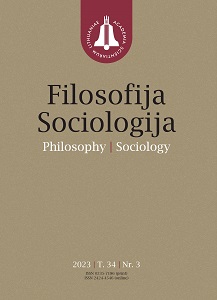Anna-Teresa Tymieniecka’s Proposition of the New Critique of Reason. Imagination–Creativity–Freedom
Anna-Teresa Tymieniecka’s Proposition of the New Critique of Reason. Imagination–Creativity–Freedom
Author(s): Magdalena MruszczykSubject(s): Existentialism, Phenomenology, Ontology
Published by: Lietuvos mokslų akademijos leidykla
Keywords: phenomenology of life; creative imagination; logos of life; freedom; intuition of life;
Summary/Abstract: Phenomenology is one of the main currents of modern philosophy. Philosophers most often understand it from the perspective of Edmund Husserl’s (1859–1938) phenomenology as a concept of cognition and a method of viewing and describing what is directly given, i.e. a phenomenon. In addition, phenomenology is the fundamental science – prima philosophia that determines what and how is directly given. Roman Ingarden (1893–1970), a student of E. Husserl, was the first thinker in Poland who practiced philosophy in a phenomenological way. R. Ingarden contributed to the dissemination of Husserl’s phenomenology in Poland and became an outstanding phenomenologist who developed an original phenomenological path proposing a creative reception of his teacher’s thoughts between World Wars II and I. Inagrden’s phenomenological path was different from Husserl’s. While Husserl developed a transcendental-idealistic form of phenomenology, Ingarden did not wholly abandon the transcendental path but went toward realism. The Polish phenomenologist did not want to question his master’s concept of the transcendental Self but only wanted to find a place for this Self in the real world. Polish thinkers who further deepened the creative reception of Husserl’s phenomenology have always gathered around Ingarden. One such person was Anna-Teresa Tymieniecka (1923–2014). Their professor-student meeting occurred at the Jagiellonian University in Krakow just after the end of World War II. Husserl’s phenomenology inspired A.-T. Tymieniecka, but this was phenomenology understood by Ingarden, taking into account the realism of the world and the entire sphere of empiricism. We can assume that the scholar’s meeting with Ingarden allowed Tymieniecka to develop her phenomenological concept, which she called the concept of the phenomenology of life and the human creative condition. It is a phenomenology that rejects idealism and chooses the realism of the world and life in the cosmic dimension. The human being here is a living entity whose life is anchored in nature but ultimately evolves and develops in culture through scientific and technological activities. In this cosmological and dynamically changing perspective, the source experience of the subject – a living being – becomes the experience of being alive and living in the unity-of-everything-there-is-alive. Therefore, Tymieniecka rejected the primordial nature of the cognitive-constitutive act of the pure consciousness, which we deal with in classical phenomenology, favoring a creative act founded in man’s creative imagination and only secondarily reflected in the cognitive act. The Polish philosopher believed that only in such a case is there a possibility of freedom in the human world of life and, thus – authentic self-realisation and self-interpretation of man in existence.
Journal: Filosofija. Sociologija
- Issue Year: 34/2023
- Issue No: 3
- Page Range: 269-279
- Page Count: 11
- Language: English

